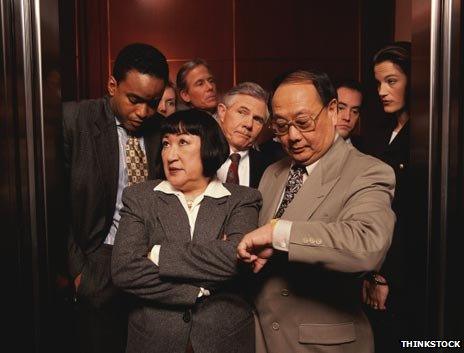Why do we behave so oddly in lifts?
- Published

Many of us use them several times a day without really noticing. And yet the way we behave in lifts, or elevators as they are known in the US, reveals a hidden anxiety.
"Most of us sort of shut down.
"We walk in. We press the button. We stand perfectly still."
Taking the lift could be the least memorable part of your journey to work, but Dr Lee Gray of the University of North Carolina at Charlotte has made it his business to scrutinise this overlooked form of public transportation. People refer to him as "the Elevator Guy".
"The lift becomes this interesting social space where etiquette is sort of odd," he explains. "They are socially very interesting but often very awkward places."
Conversations that have been struck up in the lobby tend to be extinguished quite quickly in the thick atmosphere of the office elevator. We walk in and usually turn around to face the door.
If someone else comes in, we may have to move. And here, it has been observed that lift-travellers unthinkingly go through a set pattern of movements, as predetermined as a square dance.
On your own, you can do whatever you want - it's your own little box.
If there are two of you, you take different corners. Standing diagonally across from each other creates the greatest distance.
When a third person enters, you will unconsciously form a triangle (breaking the analogy that some have made with dots on a dice). And when there is a fourth person it's a square, with someone in every corner. A fifth person is probably going to have to stand in the middle.
Now we are in uncharted territory. New entrants to the lift will need to size up the situation when the doors slide open and then act decisively. Once in, for most people the protocol is simple - look down, or examine your phone.
Why are we so awkward in lifts?
"You don't have enough space," says Professor Babette Renneberg, a clinical psychologist at the Free University of Berlin.
"Usually when we meet other people we have about an arm's length of distance between us. And that's not possible in most elevators, so it's a very unusual setting. It's unnatural."
In such a small, enclosed space it becomes vital, she says, to act in a way that cannot be construed as threatening, odd or in any way ambiguous. The easiest way to do this is to avoid eye-contact.
But perhaps there is more to it than just social awkwardness.
"In the back of our minds we are a little anxious," says Nick White, an office worker in New York who was unfortunate enough to be trapped in a lift for 41 hours.
"We don't like to be locked into a place. We want to get out of the elevator as soon as possible, because, you know, it's a creepy place to be."
During his ordeal, he began to think of another enclosed space that lurks at the back of our minds - a tomb.
It would be understandable if White refused ever to step in a lift again. But if you work in a city built on a vertical plane, and if you have aspirations above being a receptionist, that isn't an option.
"I certainly remember what happened to me every time I go in one," he admits. "It's part of the commute, the part you have the least control over."
Elevator Guy Lee Gray agrees that a sense of disempowerment is the main cause of lift anxiety.
"You're in a machine that's moving, over which you have no control. You cannot see the elevator engine, you don't know how it's working," he says.
This sense of passivity in the hands of a machine may become more pronounced as we enter the age of buttonless "smart" elevators.
After swiping through security or touching a central control panel, travellers are directed to a lift that has been programmed to stop at their floor, removing the need for any further commands. The system is designed to cut down on unnecessary stops, but although more efficient, some people find the experience unnerving.
Regardless of the qualms and anxieties associated with lifts, Gray is adamant that they are safer than cars - and significantly safer than escalators.
"It is in in fact of one of the safest forms of transportation, if you look at the billions of miles that lifts travel every year and the very, very small number of accidents."
We all know this, which is why we continue to take lifts every day, despite our anxieties.
"We have learned that we can take an elevator and it is safe to do so," says Renneberg. "So in a way it's a triumph of rationalism over our more animalistic instincts."
This pleasing thought - that we become more sophisticated by travelling in lifts - is perhaps one to ponder next time you get in one.
Just don't, whatever you do, start a conversation about it.
The Why Factor is broadcast on BBC World Service on Fridays at 18:30 GMT. Listen to the elevators episode via iPlayer or The Why Factor download.
- Published13 September 2012
- Published18 December 2011